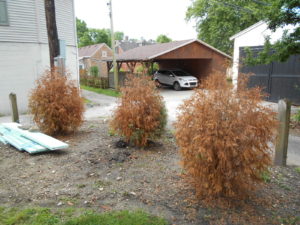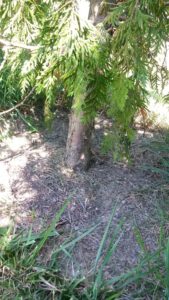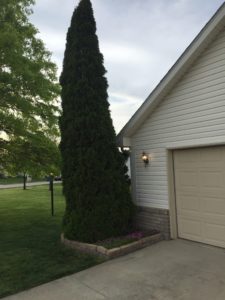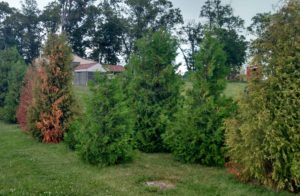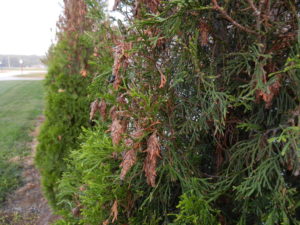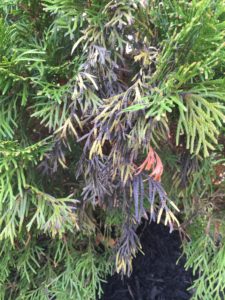Arborvitae varieties (Thuja spp.) provide some of our most beautiful and versatile evergreens for landscapes, with an extensive selection of sizes and types. Unless they get proper care, they also give us some frustrating failures. Here is my list of the most frequently encountered ‘Arborvitae Aggravations’, based on the samples and questions we get in the PPDL; in no particular order.
- Transplant stress: Transplant stress is a normal result of planting or moving any tree or large shrub but it is frequently more serious for conifers like arborvitae. If the plant has dried out at any point before transplant the stress and browning of foliage will be much worse. Don’t keep root systems soggy wet but do make sure they stay evenly moist until planting. During the first summer be especially vigilant about watering. Keep soil evenly moist and make sure water penetrates into the full root zone. After establishment irrigation should only be needed during extended dry spells.
- Small root ball: This is a contributor to transplant stress and poor survival. For balled and burlapped (B&B) plants consider whether the root system is large enough to support the amount of top growth before purchasing plants. For container grown plants check to see whether the root system has filled the current container. If the outer edge of the container is just loose media then the root ball you are getting actually has considerable less volume than the pot size. This usually happens when field grown plants are recently dug and potted up. Plants with too small root systems may survive but they will struggle to produce new roots and will require much more attention.
- Planting too deeply/drowning: The goal in setting the planting depth is to replicate how the tree or shrub would look if grew in the site from a small seedling or cutting. Planting at the same depth as found in the nursery is the usual recommendation but sometimes trees are planted too deeply in the nursery. Adding to that by planting even deeper in the landscape can lead to root death caused by saturated soils and lack of oxygen.
- Planting too deep
- Poor positioning
- Planting too close together: Homeowners, who wanted a really dense screen rapidly, often plant arborvitae far too close together. As they grow the competition for light, root space, water and nutrients mean the plants suffer. Also allow for final height. This arborvitae probably looked great at the corner of the garage until it grew too tall and had to grow around the eave of the house. Think ahead and space arborvitae wide enough to place properly to allow for their projected mature size and height.
- Poor soil/site conditions: Avoid planting in sites with very poor, rocky soil and in drought or flood prone sites.
- Drought stress: Arborvitae need well drained soils but they also need even soil moisture, not an easy balance to achieve in many sites. Irrigate deeply about once a week during extended dry periods to encourage deeper root growth.
- Drought Stress
- Bagworm
- Bagworms and Spider mites: These are the most common and serious insect/mite pests of arborvitae. Monitor for bagworms regularly. Bagworm management recommendations: https://extension.entm.purdue.edu/publications/E-27/E-27.html. Spider mite management recommendations: https://extension.entm.purdue.edu/publications/E-42.pdf
-
Black leaves (black flags): Arborvitae foliage sometimes turns black in small areas, for no apparent reason. We have searched for insects, diseases and abiotic causes related to this with many clinic samples and have never found a specific cause. Physical injury seems to be the most likely cause but can’t usually be confirmed. The good news is that the black discoloration rarely spreads and should just be pruned out.
Disease problems are infrequent but we occasionally see fungal diebacks caused by Botryosphaeria, Sphaeropsis, Phyllosticta and Diplodia. These fungi tend to attack wounded or stressed plants so good care is the best defense. The only treatment is to prune out dead stems since fungicide applications are not effective.
In the right site with proper planting and good care arborvitae will reward you with many years of beauty.
